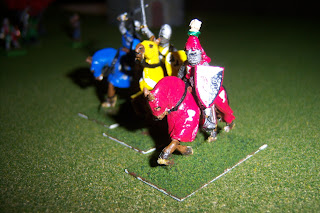Part 2 of the Tournament
Using the knights and knaves rules we set out to learn the basics and make the game play fit the narrative we wanted to express.
The players:
Jess (Scottish Lord) Clans Lambet, Campbell

Mike (Scottish Lord) Clans Braun, Comyn
We organized our forces according to the breakdown laid out in K&K and quickly decided that we would provide three mounted figures each. These "combatants" would range from knight to lord in experience / skill level. The various foot figures on the table would represent our commanders and audience who of course would not be in play.
Turn 1:
 The blue knights? Despite the K&K rules being simultaneous / declared action combat resolution we decided to use a initiative roll off to determine who declares actions first. Since jousting was fairly straight forward (Charge an hit the other guy with stick...) we started the joust at a good distance, measured each figures full movement distance (24") and resolved combat in the center. In this case the weapon skills of each knight were so close it came down to a simple D10 roll off. Jess rolled a 9 and Mike rolled a 8, Mike's knight was done for the day.
The blue knights? Despite the K&K rules being simultaneous / declared action combat resolution we decided to use a initiative roll off to determine who declares actions first. Since jousting was fairly straight forward (Charge an hit the other guy with stick...) we started the joust at a good distance, measured each figures full movement distance (24") and resolved combat in the center. In this case the weapon skills of each knight were so close it came down to a simple D10 roll off. Jess rolled a 9 and Mike rolled a 8, Mike's knight was done for the day.Turn 2:
 Comyn vs. (Red knight): Jess used very generic names for this first attempt at rules exploration. Mike used historical reference to improve gaming experience. Keep this in mind when playing historical campaigns - the more information the better! In this turn - a similar scenario to turn one, the Red Knight de-horses Comyn with a luck die roll. An orange line helps maintain the jousting boundaries
Comyn vs. (Red knight): Jess used very generic names for this first attempt at rules exploration. Mike used historical reference to improve gaming experience. Keep this in mind when playing historical campaigns - the more information the better! In this turn - a similar scenario to turn one, the Red Knight de-horses Comyn with a luck die roll. An orange line helps maintain the jousting boundariesTurn 3:
 The Red Knight and Comyn square off after de-horsing to finish the fight. The ladies gasp, the crowd grows silent after the rush of crashing armor. The two skilled swordsmen dance around each other looking for a weak point. Suddenly Comyn strikes out attempting to hit the Red Knights left knee -
The Red Knight and Comyn square off after de-horsing to finish the fight. The ladies gasp, the crowd grows silent after the rush of crashing armor. The two skilled swordsmen dance around each other looking for a weak point. Suddenly Comyn strikes out attempting to hit the Red Knights left knee -
with a flash of steel on shield the Red Knight deflects the blow and steps aside, his blunted tournament weapon crashes down on his opponents helm causing a small laceration. The wound is minor but bleeds prolifically. Comyn ceeds the contest to the Red Knight in the spirit of good sportsmanship.
Turn 4:
 Not to be outdone on his own turf The Bruce challenges Lambet to the final joust. The two impressive lords take their positions on either side of the field.
Not to be outdone on his own turf The Bruce challenges Lambet to the final joust. The two impressive lords take their positions on either side of the field.The two destriers with their erstwhile riders seemed to move in slow motion towards one another.. clouds of mud were kicked up by their hooves and swords came to the ready. The clash was sudden and violent. The riders were locked in combat with their steeds maneuvering to gain advantage. Blow after blow struck home until finally The Bruce was unhorsed. The two knights called a truce and declared Lambet the winner. The host, ever gracious gifted him with the purse and all people there on that great day retired together in peace and merriment to feast on deer poached from an English forrest. Wine and cider flowed freely and dancing continued until the late hours.
A great day indeed.
Next time: the first border skirmish, move to contact, death and taxes.




